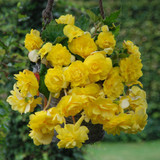Product Description
This Begonia Pendula Double Giant Collection is a great sight in the garden when its blooms burst into colour, producing an amazing cascading effect from baskets and window boxes. Supplied as giant 3/4cm tubers, these are the largest double flowers you can grow from any tuber. Flowering from June through to October, this collection will provide you with an impressive summer display. From this collection you will receive 3 each of Pink, Red, White, Orange, and Yellow.
Plant Size
| Mature Height | 30 cm |
|---|---|
| Mature Spread | 20 cm |
| Plant Spacing | 10 cm |
| Annual Growth | 30 cm |
Planting Notes
| Planting | Plant tubers slightly below soil level |
|---|---|
| Soil Type | Fertile soil, with plenty of leaf mould |
Growing at a glance…
Plant your Begonia tubers in early spring, as long as all threat of further frosts has disappeared. Begonias are incredibly sensitive blooms and need to be protected from harsh cold weather. Tubers can be started indoors as early as February if the weather is too unpredictable. Plant hollow side up, 2cm apart and 2.5cm deep. When leaves begin to appear, plant outside in your desired spot that receives plenty of sunlight. Water regularly during warm and dry weather.















 Begonia Giant Cascading Pink 3/4cm
Begonia Giant Cascading Pink 3/4cm Begonia Giant Cascading Red 3/4cm
Begonia Giant Cascading Red 3/4cm Begonia Giant Cascading White 3/4cm Tubers
Begonia Giant Cascading White 3/4cm Tubers Begonia Giant Cascading Orange 3/4cm Tubers
Begonia Giant Cascading Orange 3/4cm Tubers Begonia Giant Cascading Yellow 3/4cm Tubers
Begonia Giant Cascading Yellow 3/4cm Tubers